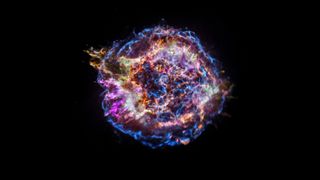Powerful cosmic explosions left abundant stardust in our solar system
More than 25%of the stardust in our planetary system may have been seeded there when supergiant stars exploded.

Recent research has revealed the amount of stardust created by supergiant stars and spread through space by massive cosmic explosions called supernovas present in the solar system is greater than previously believed.
The revised analysis of stardust has been made possible by the NanoSIMS ion probe which is capable of measuring the distribution of isotopes — atoms of an element with the same number of protons but a different number of neutrons — created by supergiant stars.
The findings could have important ramifications for our understanding of the formation of our solar system. This is because this stardust was part of the interstellar medium that eventually became the building blocks from which the sun and its planets were born.
Related: What is a supernova?
"Knowing that a much larger fraction of stardust comes from supernova explosions provides researchers with important new parameters to create computer models of dust evolution in the interstellar medium [the material that exists between star systems]," Max Planck Institute Department of Particle Chemistry researcher Peter Hoppe said in a statement. "This is especially true when describing the survival of freshly produced supernova dust and old interstellar dust as supernova shock waves pass through."
Hoppe led a recent review of recent stardust research that confirms that supergiant stars and the supernovas that mark the end of their lives could be responsible for over 25 percent of the stardust in the solar system.
A supernova delivery system
During the lifetime of stars, they act as massive nuclear fusion furnaces taking lighter elements and fusing them together producing copious amounts of energy and progressively heavier elements such as carbon and uranium.
Get the Space.com Newsletter
Breaking space news, the latest updates on rocket launches, skywatching events and more!
At the end of the lives of stars when the raw materials for fusion cease the collapse of their cores begins. In the most massive stars, this triggers massive supernova explosions that blast the elements these stars have created out into space.
These elements eventually reach the interstellar medium with a large fraction of the non-volatile elements condensing into stardust. While some of this material is destroyed, what remains is eventually incorporated into the next generation of stars as well as the planetary systems that form around them.
This process was occurring in our region of space over 4.6 billion years before the formation of the sun and its planets. As it predates the formation of the solar system, scientists call this material 'presolar grains.'
The elements synthesized in supergiant stars have unusual isotope patterns not common in the solar system.
Because comets and meteorites spend much of their time away from the sun, the material that comprises them is relatively 'unspoiled' by solar radiation remaining a good representation of the matter from which the solar system formed.
That means scientists can detect the presence of presolar grains from supernovas in meteorites and comets which are formed from material left over after the planets of the solar system's star and planets were created.
Presolar grains themselves can provide scientists with a similar look at the stellar fusion processes that created them and the type of stars from which they may have originated.
Hoppe suggested that future research of this kind will explore the processes that cause supernova-launched stardust to mix with the interstellar medium in order to create more robust evolutionary models for planetary systems like our solar system.
Hoppe and his team's research is published in the latest edition of the journal Nature Astronomy.
Follow us on Twitter @Spacedotcom or on Facebook.
Join our Space Forums to keep talking space on the latest missions, night sky and more! And if you have a news tip, correction or comment, let us know at: community@space.com.

Robert Lea is a science journalist in the U.K. whose articles have been published in Physics World, New Scientist, Astronomy Magazine, All About Space, Newsweek and ZME Science. He also writes about science communication for Elsevier and the European Journal of Physics. Rob holds a bachelor of science degree in physics and astronomy from the U.K.’s Open University. Follow him on Twitter @sciencef1rst.
Most Popular

